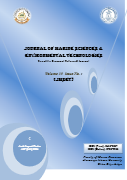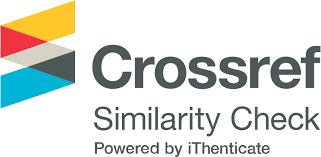مقاومة المضادات الحيوية في عزلات بكتيرية من عينات المياه العذبة ومياه البحر في مدينة زليتن - ليبيا
DOI:
https://doi.org/10.59743/jmset.v10i1.182الكلمات المفتاحية:
البكتيريا المقاومة للمضادات الحيوية، تسلسل جين SrRNA 16، البحر الأبيض المتوسط، مياه وادي كعام، زليتن ليبياالملخص
يعتبر الماء أكثر البيئات ملائمة لنمو مختلف أشكال الحياة، حيت يعتبر مستودعا لمجموعة واسعة من البكتيريا المقاومة للمضادات الحيوية، وتشمل البكتيريا المسببة للأمراض والتي لديها القدرة على مقاومة المضادات الحيوية مما يشكل مخاطر على الصحة العامة. في هذه الدراسة، تم تحديد مقاومة العزلات البكتيرية من البحر والمياه العذبة في زليتن - ليبيا لعدد خمس مضادات حيوية توصف بشكل متكرر. ولوحظ أن التسلسل الأول LC532105 من مياه وادي كعام يُظهر تشابهًا مع سلالة Citrobacter freundii NCTC9750، ويُظهر التسلسل الثاني LC532106 تشابهًا مع سلالة Bacillus pumilus ATCC 7061، ويُظهر التسلسل الثالث LC532107 تشابهًا مع سلالة Bacillus megaterium ATCC 14581. يُظهر التسلسل الرابع من مياه البحر تشابهًا مع سلالة Citrobacter freundii NCTC9750، ويُظهر التسلسل الخامس تشابهًا مع سلالة Proteus vulgaris ATCC 29905، بينما يُظهر التسلسل الأخير تشابهًا مع سلالة Pseudomonas aeruginosa DSM 50071. سلالة النوع الأول والرابع (Citrobacter freundii) غير سامة، بينما كانت الأنواع الثانية والثالثة والخامسة والسادسة سامة، وخاصةً Pseudomonas aeruginosa. أظهرت جميع العزلات البكتيرية مقاومةً للسيفوتاكسيم (Cefotaxime). توصي الدراسة بالتحليل الدوري للخصائص الفيزيائية والكيميائية ومقاومة المضادات الحيوية في المياه السطحية.
التنزيلات
المراجع
Vilca, F. Z., & Angeles, W. G. (2018). Occurrence of Antibiotics Residues in the Marine Environment. Examines Mar. Biol. Ocean, 2, 12-14.
Irfan, S., & Alatawi, A. M. M. (2019). Aquatic ecosystem and biodiversity: a review. Open Journal of Ecology, 9(1), 1-13.
Hassan, B., Qadri, H., Ali, M. N., Khan, N. A., & Yatoo, A. M. (2020). Impact of climate change on freshwater ecosystem and its sustainable management. Fresh Water Pollution Dynamics and Remediation, 105-121.
World Health Organization (2017). WHO Publishes List of Bacteria for Which New Antibiotics Are Urgently Needed. World Health Organization [Internet]Available: https://www.who.int/news/item/27-02-2017-who-publishes-list-of-bacteria-for-which-new-antibiotics-are-urgently-needed (Accessed November 15, 2021).
World Health Organization (2021). Antimicrobial Resistance. World Health Organization [Internet]. 2021.
[Internet]Available: https://www.who.int/news-room/fact sheets/detail/antimicrobial-resistance (Accessed November 15, 2021).
Poretsky, R., Rodriguez-R, L. M., Luo, C., Tsementzi, D., & Konstantinidis, K. T. (2014). Strengths and limitations of 16S rRNA gene amplicon sequencing in revealing temporal microbial community dynamics. PloS one, 9(4), e93827.
Moyane, J. N., Jideani, A. I. O., & Aiyegoro, O. A. (2013). Antibiotics usage in food-producing animals in South Africa and impact on human: Antibiotic resistance. Afr. J. Microbiol. Res, 7(24), 2990-2997.
Batt, A. L., Kim, S., & Aga, D. S. (2007). Comparison of the occurrence of antibiotics in four full-scale wastewater treatment plants with varying designs and operations. Chemosphere, 68(3), 428-435.
Schwartz, T., Kohnen, W., Jansen, B., & Obst, U. (2003). Detection of antibiotic-resistant bacteria and their resistance genes in wastewater, surface water, and drinking water biofilms. FEMS microbiology ecology, 43(3), 325-335.
AbdelRahim, K. A. A., Hassanein, A. M., & Abd El, H. A. E. H. (2015). Prevalence, plasmids and antibiotic resistance correlation of enteric bacteria in different drinking water resources in sohag, egypt. Jundishapur journal of microbiology, 8(1).
Guzman-Otazo, J., Gonzales-Siles, L., Poma, V., Bengtsson-Palme, J., Thorell, K., Flach, C. F., ... & Sjöling, Å. (2019). Diarrheal bacterial pathogens and multi-resistant enterobacteria in the Choqueyapu River in La Paz, Bolivia. PLoS One, 14(1), e0210735.
Singh, A. K., Das, S., Kumar, S., Gajamer, V. R., Najar, I. N., Lepcha, Y. D., ... & Singh, S. (2020). Distribution of antibiotic-resistant Enterobacteriaceae pathogens in potable spring water of eastern Indian Himalayas: emphasis on virulence gene and antibiotic resistance genes in Escherichia coli. Frontiers in Microbiology, 11, 581072.
Guardabassi, L., Petersen, A., Olsen, J. E., & Dalsgaard, A. (1998). Antibiotic resistance in Acinetobacter spp. isolated from sewers receiving waste effluent from a hospital and a pharmaceutical plant. Applied and Environmental Microbiology, 64(9), 3499-3502.
Chagas, T. P. G., Seki, L. M., Cury, J. C., Oliveira, J. A. L., Dávila, A. M. R., Silva, D. M., & Asensi, M. D. (2011). Multiresistance, beta‐lactamase‐encoding genes and bacterial diversity in hospital wastewater in Rio de Janeiro, Brazil. Journal of applied microbiology, 111(3), 572-581.
Marathe, N. P., Shetty, S. A., Shouche, Y. S., & Larsson, D. J. (2016). Limited bacterial diversity within a treatment plant receiving antibiotic-containing waste from bulk drug production. PLoS One, 11(11), e0165914.
Turolla, A., Cattaneo, M., Marazzi, F., Mezzanotte, V., & Antonelli, M. (2018). Antibiotic resistant bacteria in urban sewage: Role of full-scale wastewater treatment plants on environmental spreading. Chemosphere, 191, 761-769.
Adbarzi, S. S. M., Tripathi, P., Choudhary, K. K., Kant, R., & Tripathi, V. (2020). Assessment of physico-chemical properties of pre and post-treated wastewater of Prayagraj region and its effect on nearby Ganges river. Vegetos, 33(2), 258-264.
Alexander, J., Hembach, N., & Schwartz, T. (2020). Evaluation of antibiotic resistance dissemination by wastewater treatment plant effluents with different catchment areas in Germany. Scientific Reports, 10(1), 8952.
Amarasiri, M., Sano, D., & Suzuki, S. (2020). Understanding human health risks caused by antibiotic resistant bacteria (ARB) and antibiotic resistance genes (ARG) in water environments: Current knowledge and questions to be answered. Critical Reviews in Environmental Science and Technology, 50(19), 2016-2059.
Chauhan, N. S., & Punia, A. (2023). Antibiotic pollution and antibiotic-resistant bacteria in water bodies. In Degradation of Antibiotics and Antibiotic-Resistant Bacteria from Various Sources (pp. 179-201). Academic Press.
Henriques, I. S., Fonseca, F., Alves, A., Saavedra, M. J., & Correia, A. (2006). Occurrence and diversity of integrons and β-lactamase genes among ampicillin-resistant isolates from estuarine waters. Research in microbiology, 157(10), 938-947.
Zhang, X. X., Zhang, T., & Fang, H. H. (2009). Antibiotic resistance genes in water environment. Applied microbiology and biotechnology, 82, 397-414.
Guo, X., Tang, N., Lei, H., Fang, Q., Liu, L., Zhou, Q., & Song, C. (2021). Metagenomic analysis of antibiotic resistance genes in untreated wastewater from three different hospitals. Frontiers in Microbiology, 12, 709051.
Berger-Bächi, B. (2002). Resistance mechanisms of gram-positive bacteria. International Journal of Medical Microbiology, 292(1), 27-35.
CytoGene Research & Development Laboratory : K-51, Agro Park, UPSIDC Industrial Area, Kursi Road (Lucknow) Dist-Barabanki – 2250.
Murray, P.R., Baron, E.J., Pfaller, M.A., Tenover, F.C. & Yolken, R.H.. (1995). Manual of Clinical Microbiology, 6th edition. American Society of Microbiology Press, Washington DC. 1482 p.
Clinical and Laboratory Standards Institute. Performance Standards for Antimicrobial Susceptibility Testing: Twenty Sixth Informational Supplement. CLSI Document M100-S26”. Wayne, PA: Clinical and Laboratory Standards Institute (2016).
World Health Organization (2014). Antimicrobial Resistance Global Report on Surveillance. Geneva: World Health Organization. Available at: https://apps.who.int/iris/handle/10665/112642 (Accessed November 12, 2021).
World Health Organization (2015). Global Action Plan on Antimicrobial Resistance. Geneva: World Health Organization. Available at: https://www.who.int/publications/i/item/9789241509763. (Accessed November 15, 2021).
Adler, A., Katz, D. E., & Marchaim, D. (2016). The continuing plague of extended-spectrum β-lactamase–producing Enterobacteriaceae infections. Infectious Disease Clinics, 30(2), 347-375.
Bush, K. (2018). Past and present perspectives on β-lactamases. Antimicrobial agents and chemotherapy, 62(10), 10-1128.
Bush, K., & Bradford, P. A. (2020). Epidemiology of β-lactamase-producing pathogens. Clinical microbiology reviews, 33(2), 10-1128.
Tacão, M., Laço, J., Teixeira, P., & Henriques, I. (2022). CTX-M-producing bacteria isolated from a highly polluted river system in Portugal. International Journal of Environmental Research and Public Health, 19(19), 11858.
Yamaguchi, A. (1997). Bacterial resistance mechanisms for tetracyclines. Nihon rinsho. Japanese Journal of Clinical Medicine, 55(5), 1245-1251.
Nawaz, M., Khan, A. A., Khan, S., Sung, K., & Steele, R. (2008). Isolation and characterization of tetracycline-resistant Citrobacter spp. from catfish. Food microbiology, 25(1), 85-91.
Poirel, L., Ros, A., Carricajo, A., Berthelot, P., Pozzetto, B., Bernabeu, S., & Nordmann, P. (2011). Extremely drug-resistant Citrobacter freundii isolate producing NDM-1 and other carbapenemases identified in a patient returning from India. Antimicrobial agents and chemotherapy, 55(1), 447-448.
Raman, G., Avendano, E. E., Chan, J., Merchant, S., & Puzniak, L. (2018). Risk factors for hospitalized patients with resistant or multidrug-resistant Pseudomonas aeruginosa infections: a systematic review and meta-analysis. Antimicrobial Resistance & Infection Control, 7, 1-14.
Tabak, Y. P., Merchant, S., Ye, G., Vankeepuram, L., Gupta, V., Kurtz, S. G., & Puzniak, L. A. (2019). Incremental clinical and economic burden of suspected respiratory infections due to multi-drug-resistant Pseudomonas aeruginosa in the United States. Journal of Hospital Infection, 103(2), 134-141.
Kunz Coyne, A. J., El Ghali, A., Holger, D., Rebold, N., & Rybak, M. J. (2022). Therapeutic strategies for emerging multidrug-resistant Pseudomonas aeruginosa. Infectious diseases and therapy, 11(2), 661-682.
Livermore, D. M., Williams, J. D., & Davy, K. W. (1985). Cephalosporin resistance in Pseudomonas aeruginosa, with special reference to the proposed trapping of antibiotics by beta-lactamase. Chemioterapia: International Journal of the Mediterranean Society of Chemotherapy, 4(1), 28-35.
Kim, E. S., & Hooper, D. C. (2014). Clinical importance and epidemiology of quinolone resistance. Infection & chemotherapy, 46(4), 226-238.
Hooper, D. C., & Jacoby, G. A. (2015). Mechanisms of drug resistance: quinolone resistance. Annals of the New York academy of sciences, 1354(1), 12-31.
Adbarzi, S. S. M., Tripathi, P., Kant, R., & Tripathi, V. (2020). Assessment of bacterial diversity and their antibiotic resistance profiles in wastewater treatment plants and their receiving Ganges River in Prayagraj (Allahabad), India. Vegetos, 33(4), 744-749.
Berger-Bächi, B. (2002). Resistance mechanisms of gram-positive bacteria. International Journal of Medical Microbiology, 292(1), 27-35.
Munita, J. M., Bayer, A. S., & Arias, C. A. (2015). Evolving resistance among Gram-positive pathogens. Clinical Infectious Diseases, 61(suppl_2), S48-S57.
Duc, L. H., Hong, H. A., Barbosa, T. M., Henriques, A. O., & Cutting, S. M. (2004). Characterization of Bacillus probiotics available for human use. Applied and environmental microbiology, 70(4), 2161-2171.
Adamski, P., Byczkowska-Rostkowska, Z., Gajewska, J., Zakrzewski, A. J., & Kłębukowska, L. (2023). Prevalence and antibiotic resistance of Bacillus sp. isolated from raw milk. Microorganisms, 11(4), 1065.
O'Hara, C. M., Brenner, F. W., & Miller, J. M. (2000). Classification, identification, and clinical significance of Proteus, Providencia, and Morganella. Clinical microbiology reviews, 13(4), 534-546.
Stock, I. (2003). Natural antibiotic susceptibility of Proteus spp., with special reference to P. mirabilis and P. penneri strains. Journal of chemotherapy, 15(1), 12-26.
Kim, B. N., Kim, N. J., Kim, M. N., Kim, Y. S., Woo, J. H., & Ryu, J. (2003). Bacteraemia due to tribe Proteeae: a review of 132 cases during a decade (1991–2000). Scandinavian journal of infectious diseases, 35(2), 98-103.
Owoseni, M. C., Oyigye, O., Sani, B., Lamin, J., & Chere, A. (2021). Antimicrobial resistance and Virulence genes profiling of proteus species from poultry farms in Lafia, Nigeria. BioRxiv, 2021-01.
Bush, K., Jacoby, G. A., & Medeiros, A. A. (1995). A functional classification scheme for beta-lactamases and its correlation with molecular structure. Antimicrobial agents and chemotherapy, 39(6), 1211-1233.
Perilli, M., Segatore, B., Rosaria De Massis, M., Riccio, M. L., Bianchi, C., Zollo, A., ... & Amicosante, G. (2000). TEM-72, a new extended-spectrum β-lactamase detected in Proteus mirabilis and Morganella morganii in Italy. Antimicrobial agents and chemotherapy, 44(9), 2537-2539.
Pagani, L., Migliavacca, R., Pallecchi, L., Matti, C., Giacobone, E., Amicosante, G., ... & Rossolini, G. M. (2002). Emerging extended-spectrum β-lactamases in Proteus mirabilis. Journal of clinical microbiology, 40(4), 1549-1552.
Song, W., Kim, J., Bae, I. K., Jeong, S. H., Seo, Y. H., Shin, J. H., ... & Lee, K. (2011). Chromosome-encoded AmpC and CTX-M extended-spectrum β-lactamases in clinical isolates of Proteus mirabilis from Korea. Antimicrobial agents and chemotherapy, 55(4), 1414-1419.
Philippon, A., Labia, R., & Jacoby, G. (1989). Extended-spectrum beta-lactamases. Antimicrobial agents and chemotherapy, 33(8), 1131-1136.
Stock, I. (2003). Natural antibiotic susceptibility of Proteus spp., with special reference to P. mirabilis and P. penneri strains. Journal of chemotherapy, 15(1), 12-26.
Gales, A. C., & Jones, R. N. (2000). Antimicrobial activity and spectrum of the new glycylcycline, GAR-936 tested against 1,203 recent clinical bacterial isolates. Diagnostic microbiology and infectious disease, 36(1), 19-36.
Mokracka, J., Gruszczyńska, B., & Kaznowski, A. (2012). Integrons, β-lactamase andqnrgenes in multidrug resistant clinical isolates ofProteus mirabilisandP. vulgaris. APMIS, 120(12), 950-958.
Guillard, T., Grillon, A., de Champs, C., Cartier, C., Madoux, J., Berçot, B., ... & Cambau, E. (2014). Mobile insertion cassette elements found in small non-transmissible plasmids in Proteeae may explain qnrD mobilization. PLoS One, 9(2), e87801.
الملفات الإضافية
منشور
إصدار
القسم
الرخصة
الحقوق الفكرية (c) 2025 Soad Adbarzi, Mansor M. Alholi, Alkasm H. Shukshuk, Ali Almashgab, Hanan O.M. Altunsi

هذا العمل مرخص بموجب Creative Commons Attribution-ShareAlike 4.0 International License.












